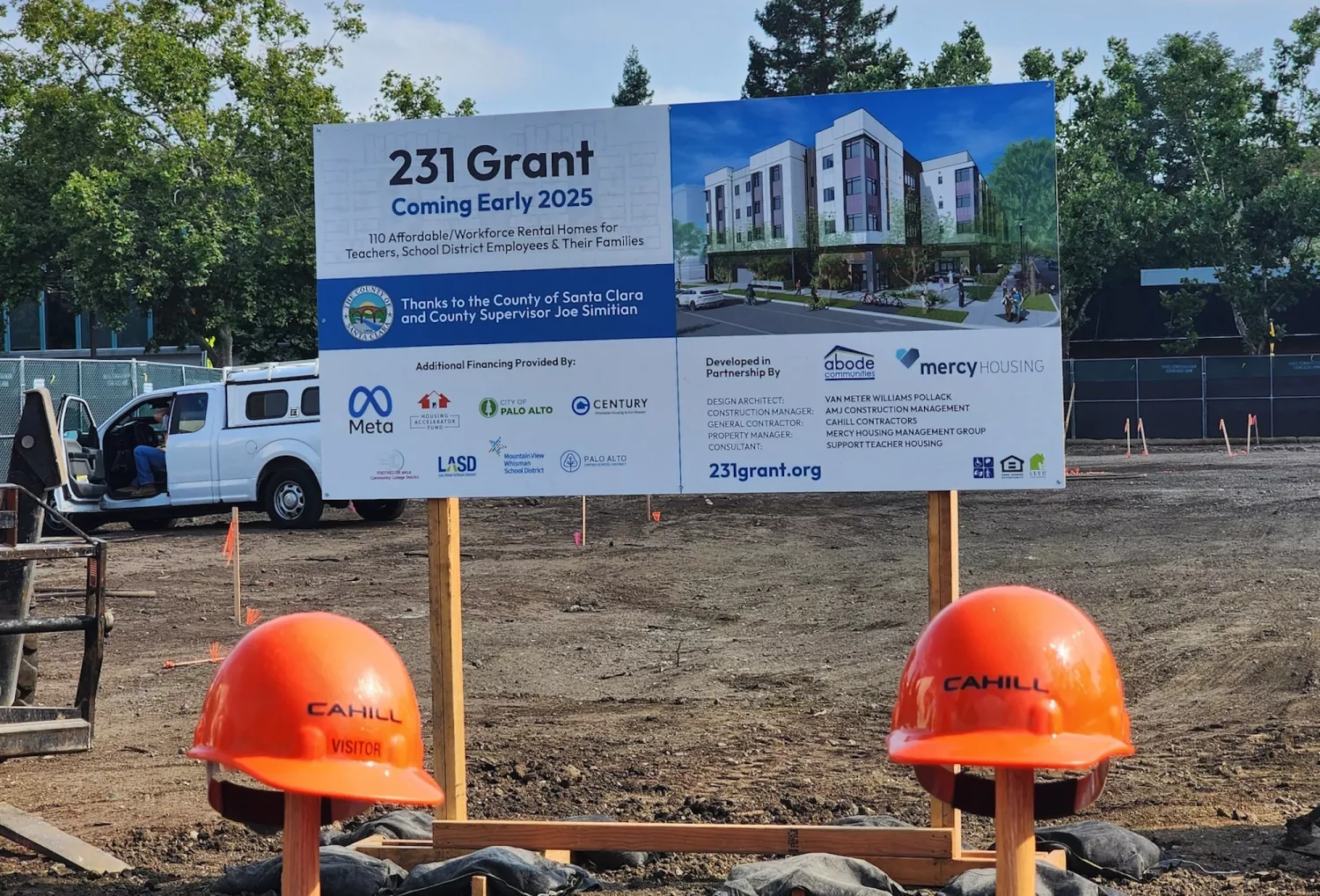Key Takeaways
- Skyrocketing rents and home prices in many school districts are preventing prospective teachers and school staff from taking or keeping jobs.
- While securing higher educator pay remains paramount, educators and their unions are stepping up their advocacy for affordable housing.
- Facing acute staff shortages and high housing costs, a growing number of communities are exploring workforce housing as a recruitment and retention strategy.
In 2023, in her eighth year as a teacher, Zoe Gierman finally moved into her own place. Previously, as she earned her master’s degree and moved up the salary schedule, Gierman, an elementary school teacher in Santa Fe, New Mexico, had always shared an apartment or small house with roommates.
Gierman is now a tier-three teacher—the highest paid category in the state. With the help of a significant pay raise signed into law in 2022, she can finally afford to live independently.
“Santa Fe is a beautiful place and I love teaching,” she says. “Can I live here on my salary? Yes, but it has been very difficult. At least I can now rent a place without roommates.”
On the other hand, the possibility of ever buying a home? "That's off the table," she quickly adds.
Always expensive, Santa Fe has become unaffordable for many residents, especially new public school educators. Housing prices here have continued to rise even as costs in other cities, including Albuquerque and Las Cruces, have leveled off.
“I’m at the top of my salary schedule,” says Gierman. “I cannot imagine how a new teacher is supposed to cope.”
For Collin Ferraro, a high school teacher in Wheat Ridge, Colorado, coping means sharing a space with up to four roommates. Ferraro, in his fourth year of teaching, lives in Denver, one of the most expensive non-coastal housing markets in the nation. According to the National Education Association, Colorado ranks 49th in starting teacher salaries.
“My living situation is challenging to say the least. I make it work, but it's not sustainable.” Ferraro says.
As Early Career Educator Chair for the Jefferson County Education Association (JCEA), Ferraro hears a lot from his counterparts about their struggles working in a district where salaries are not competitive with surrounding districts.
“Everyone talks about not enough pay and lack of affordable housing,” Ferraro says. “Those issues go hand-in-hand and they're keeping a lot of people who would like to be educators out of the profession.”

If teachers and support staff are not living with multiple roommates, they are taking on second (or third) jobs) or enduring painstakingly long commutes from a less expensive location—or all the above.
Can better pay help? Absolutely. But in a growing number of communities, those increases are not keeping pace with the cost of living.
“We’ve seen that in Santa Fe unfortunately,” reports Gierman. “Our pay raise was great news, but by itself it may not be enough to keep people in the profession. We’ve not been able to fill positions at my school. It’s a little scary.”
Increasing Costs, Diminishing Supply
In 2022, according to a report by Harvard University, half of all U.S. renters—22.4 million—were “cost burdened," meaning they were paying over 30 percent of their income on housing and utilities. Almost half had “severe burdens,” or were paying over half of their income on housing. Meanwhile, the share of cost-burdened households is greatest among middle-income renter households earning between $30,000 and $74,999 annually—an income group that includes teachers.
According to the National Education Association (NEA), the average U.S. public school teacher salary in 2021-2022 was $66,745, a slight increase from the previous year. However, when adjusted for inflation, teachers were making $3,644 less than they were a decade ago. The average starting teacher salary was $42,845, or $4,552 below 2008-2009 levels when adjusted for inflation.
As teacher salaries have stagnated, housing costs have continued to climb and the supply of affordable rental units has dwindled. A 2020 NEA survey revealed that 17 percent of teachers and 22 percent of education support professionals (ESPs) had “moderate or serious problems” making rent or mortgage payments.
In Santa Fe, NEA-Santa Fe in 2021 found that 86 percent of Santa Fe educators could not buy a home that met their family’s needs and 64 percent had experienced rent increases that caused financial hardships. Fifty-three percent were concerned about their ability to continue working in the city due to rising costs.
Quote byCollin Ferraro , Jefferson County, Colorado

“And it's only gotten worse,” says Grace Mayer, an art teacher and president of NEA-Santa Fe. "New Mexico has even more vacancies than we did last year. And this is after we all got a raise. But the problem is we have a retiring workforce, and we need people to replace us. We just can't fill these positions." Affordable housing for educators has been a central tenet of NEA-Sant Fe's organizing for years.
In Florida, which ranks 49th in teacher pay and where the cost of housing has skyrocketed, districts are scrambling to fill thousands of vacant positions. In St. Lucie County, the financial pressure has pushed some of Lynn Winn’s colleagues out of the profession—or at least to another district. A veteran high school English teacher whose own mortgage has increased by $600 over the past four years, Winn says, “It’s getting difficult to make ends meet and we’re losing good people. I had a colleague who left after a few months. She wanted to teach but just could not afford to live here.”
Housing for Educators Under Construction
Addressing the lack of affordable housing has become a key instrument to address the educator shortage—which, like high housing costs, existed long before the pandemic. Programs include tax incentives for moving to the district, mortgage assistance, and down payment reimbursement.
But as staff shortages across the country have worsened, educators and their unions have demanded districts and lawmakers take on the issue with greater urgency and look at a wider range of options. Dedicated low-cost housing for teachers and support staff is one idea that has gained momentum, particularly in California, which, despite having some of the highest teacher salaries in the U.S., also has the highest home prices and rents.
The realization that they're locked out of the housing market has steered countless teachers and support staff away from certain areas of the state, includig the San Francisco Bay Area. The median price for a home in Los Altos in Silicon Valley is around $4 million. The median rent is around $4,500—80 percent higher than the national average.

“We do have higher salaries,” says Chris Hazelton, a teacher in Los Altos and president of the Los Altos Teachers Association. “But it’s almost impossible for educators in our district to afford to rent a home without a long commute, some sort of financial help, or enduring unstable, challenging living arrangements.”
Relief, at least for some educators, may soon be on its way in the form of a new housing facility in Palo Alto. The development, scheduled to be completed in mid-2025, will offer 110 rental units to teachers and education support professionals from four neighboring districts, including Los Altos. Rents will correspond to individual salaries and the size of the apartment, and will not exceed 30 percent of an educator’s take-home pay.
Called 231 Grant, the project isn’t part of any state or federal low-income housing programs, instead relying on funding from various sources, including Santa Clara County, Meta (formerly known as Facebook), the city of Palo Alto, and the participating school districts.
Hazelton and Palo Alto Educators Association President Teri Baldwin, who is a longtime advocate for affordable educator housing, were both seated in the front row at the groundbreaking ceremony last August.
“We're glad the district took the issue seriously. Our educators’ lives will be made easier.” says Hazelton.
Growing Trend
These sorts of projects will likely become more prevalent in districts that face acute staff shortages and have a surplus of developable land, explains Jeff Vincent, director and cofounder of the Center for Cities + Schools at the University of California, Berkeley. School districts in California own 75,000 acres of potentially developable land, according to a recent study.
And state lawmakers have begun to eliminate the red tape around zoning restrictions and other obstacles, making it easier for districts to use land for this purpose.
“We weren’t really talking about this idea a few years ago,” says Vincent. “Now many districts are saying, 'Maybe housing for teachers is not as crazy of an idea as it might have sounded five years ago. So how do we think creatively about this together?’”
Districts across the country are having those very same conversations. Educator workforce housing proposals have emerged in Texas, Arkansas, Nevada, Hawaii, South Carolina, Arizona, and New Mexico.
Facing its own housing affordability crisis, Pinellas County, Florida, is considering a plan to convert a historic building in downtown St. Petersburg into 225 residential units. The Pinellas County Educational Support Professionals Association (PESPA) and Pinellas Classroom Teachers Association is urging the district to reserve half the planned units as workforce housing for teachers and school employees—with rents below market rates. Affordable housing is a pillar of the two locals’ Common Good organizing campaign.
“We need this,” says child development assistant and PESPA President Nelly Henjes, who has worked in the district for more than 30 years. “Especially our support staff, who make less than $25,000. Having people come over here and stay in the county and our community is super important.”
Both Employer and Landlord?
For some educators, the idea may raise more questions than it answers.
Depending on the location and circumstances, some of these models may make sense, says Arizona Education Association President Marisol Garcia, but there are risks. “When the school district is both your employer and your landlord, it’s that much harder to speak up about potential problems or raise concerns,” she explains. “These programs also bring up questions about fairness and who makes decisions about how limited spots will be distributed.”
In Pinellas County and Los Altos, union leadership has been mindful of the projects' potential pitfalls and has been providing input along the way, ensuring the new agreements will not leave their members vulnerable. In neither case will the district be “managing” the property.

For Collin Ferraro in Jefferson County, however, dedicated educator housing “opens up an umbrella of control that I don't think I would like a school district or my employer to have over my life.”
“Even with clear contract language around the arrangement,” he adds, “it just doesn't seem like the most ideal situation.” Ferraro favors advocating for housing policy at the local and state level.
As to the long-term effectiveness of workforce housing in attracting and keeping staff in districts, time will tell, says Jeff Vincent.
“At this point, we really don’t know. Anecdotally, many are enthusiastic and confident that it will. But research is still needed. Did the housing help with shortages? Did these developments operate successfully? Were educators living there satisfied? There are a lot of questions we will have to look at.”
And never should these proposals move forward as some sort of alternative to better pay and other solutions that will help curb shortages. “That’s the top priority and most salient point,” Ferraro says. “Wage increases across the board.”
Recruiting and retaining educators should and does start with professional pay, agrees Grace Mayer in Santa Fe. “But housing can be seen as a necessary recruiting tool. That’s where we’re headed because housing costs are out-of-bounds and are not improving anytime soon.”
NEA-Santa Fe supports a new plan to develop staff housing on a district-owned 7-acre parcel of land that sits between two schools.
“When we hire new educators, we want to keep them,” Mayer says. "When you live where you teach, your connection to your school, to your students, to your job is much greater. You’re not going to build those connections with a grueling two-hour commute every day.”


